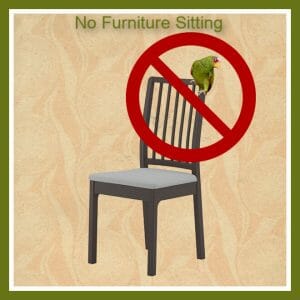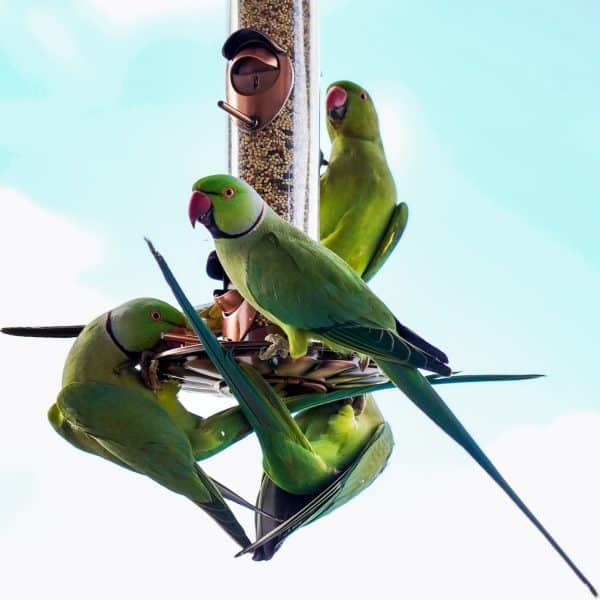Last Updated on by Catherine Tobsing
This question comes from the Google My Business community.
Unfortunately Google sets character limitations in the answer box and I felt compelled to provide a well rounded solution.
Thus you found your way to our excellent blog on nothing but pet birds and captive bird care.
kenneth s
good evening Mitch, we recently put up an outside aviary for our rescue Indian ring neck.
we do not have regular screening up because we were afraid it would keep out the UV Light.
should we use that because of bugs, bees and mosquitos?
We need help
Greetings Kenneth
We love ringnecks
I recently rescued one you can read about that here.
I don’t know your location, I’m going to assume it’s in Illinois because you reached out on GMB?
I wouldn’t worry about UV light.
There is not a shred of written evidence (trust me I’ve looked) with the conclusion that light helps birds better synthesize vitamin D.
Great for reptiles and herbivores who have a single integumentary system, their skin.
Birds have three, skin, nails and feathers.
Light must be absorbed through the skin to synthesize vitamin D3 but a bird feathers covers the skin.
As methodical as birds are, the process of preening, starting at the uropygial (preening) gland then running the goo across its feathers using it’s beak, very little of the oil ever makes it to the birds skin but is another component necessary for vitamin D synthesis
My good friend Josee Birmingham who manages https://hari.ca/ has done extensive testing with her 250 pairs of parrots.
Working in conjunction with the university of guelph’s veterinary College, she’s the only person that I know it is actually been testing for light therapy on parrots.
The facility employs 3 avian veterinarians and a number of veterinary techs on staff.
Her boss Mark Hagen, one of the three brothers that runs Hagen internationally has a Masters degree in agriculture that he is uses to engineer Hagen (HARI) bird food line
They run blood tests after scheduled exposure to full-spectrum lighting with UVA and UVB and have seen no increase whatsoever in vitamin D3 levels.
One of my many posts on birds and lighting
The good news is where convinced that light can be used to control hormonal behavior.
Simply having full-spectrum lighting no more than 6 inches over a cage set to a 12 hour on-off cycle will help synchronize a birds circadian rhythms keeping the more hormonally balanced.
We also found that exposing chronic egg laying birds (a possible death sentence) to between 72 and 168 hours of light while in a cage can shut down a bird’s reproductive system by “resetting it’s circadian clock” with no pharmaceutical intervention.
The crux of your issue is that bugs and bees are not a problem, mosquitoes are.
If mosquitoes are out, your bird should not be.
Greater danger comes from prey animals likes feral cats, rats, mice, raccoons and predatory birds.
Outdoor aviaries should not be allowed to sit on dirt or grass as animals can burrow into the ground gaining access to the cage.
An aviary must on a concrete slab or pavers.
A sharp nailed claw swipe to a sleeping bird next to a cage wall, is all it takes.
I would not leave your ringneck unsupervised as animals move rapidly when motivated by food which is the last thing you want your ringneck to become.
My intent is not to suck the fun out of the outdoor aviary adventure, simply to point out the pitfalls.
Much can be done to mitigate these issues like placing the aviary in its own outdoor room.
This video may serve as a guide
written by mitch rezman
approved by catherine tobsing
Author Profile
Latest entries
 The Traveling BirdJune 26, 2025Can You Name 5 Parrot Species That Are Living Wild in the USA?
The Traveling BirdJune 26, 2025Can You Name 5 Parrot Species That Are Living Wild in the USA? Bird BehaviorJune 26, 2025How is it Parrots Are Problem Solvers Social Animals and Even Use Tools?
Bird BehaviorJune 26, 2025How is it Parrots Are Problem Solvers Social Animals and Even Use Tools? Bird & Parrot AnatomyJune 25, 2025How a Tiny Chemical Modification Makes Parrots Nature’s Living Paintings
Bird & Parrot AnatomyJune 25, 2025How a Tiny Chemical Modification Makes Parrots Nature’s Living Paintings PigeonsJune 20, 2025How Do Parrots Thrive in Cities Outside Their Native Habitats?
PigeonsJune 20, 2025How Do Parrots Thrive in Cities Outside Their Native Habitats?



